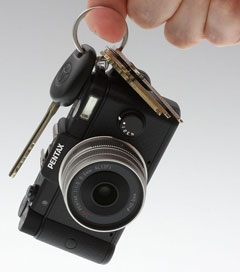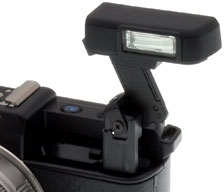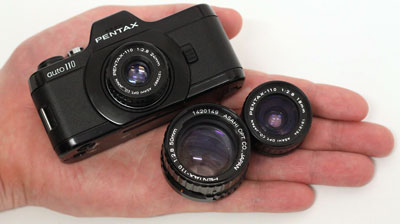"Holy crap!" was the first thing to run through my mind when I saw a
photo of the Pentax Q
on Ars Technica. The tiny interchangeable lens camera is attached
to a keychain!

Pentax Q interchangeable lens digicam.
The camera is just 3.9" wide, 2.3" tall, and 1.2" deep, presumably
with the normal lens attached. The lens is mounted with a tiny bayonet
mount to accept Q-mount lenses. The 8.5mm f/1.9 lens is almost
equivalent to the 50mm f/1.8 lenses most SLR cameras had in the 1970s
and 1980s, which means its going to be an adequate performer in lower
light situations.
Pentax plans to offer a 5-15mm (27-83mm equivalent) f/2.8-4.5 zoom,
a 35mm equivalent 6.3mm f/7.1 wide-angle lens, a 100mm equivalent 18mm
f/8 "toy" telephoto lens, and a 3.2mm f/5.6 160° fisheye lens. The
telephoto is deliberately a poor lens to mimic the cheapo plastic
lenses found on Holga and Diana film cameras, which could make it an
interesting portrait lens.
If it flies, expect more Q-mount lenses and - of course - an adapter
for Pentax K-mount lenses. Pentax has been the master of backward
compatibility: K-mount cameras could use an M42 adapter for older
thread mount lenses, Pentax 645 lenses can be adapted to K-mount
cameras, ands it's almost inconceivable that there won't be a K-mount
adapter for Q-mount cameras.

Pentax Q flash pops up in use.
The Pentax Q has a 12 megapixel sensor, has anti-shake technology,
and is built of magnesium alloy. The ISO sensitivity range of the
sensor ranges from 125 to 64000. The built-in flash is unusual in that
it pops up and off to the side a bit, which will not only reduce
chances of redeye but also prevent larger lenses from blocking some of
the flash's output. Clever! (There's also a hot shoe for use with a
more powerful flash.)
Tiny Pentax SLR from 1978
Old timers may recall the tiny 110 film cartridges, which Kodak
developed to address the fact that most cameras were too large to be
carried all the time. A Pocket Instamatic™ could go in your purse
or back pocket, and there were some very high-end models:
- The
Pocket Instamatic 60 (introduced with the 110 cartridge in 1972)
had rangefinder focus and an f/2.7 lens.
- The
Canon 110ED (1975) had a fast f/2.0 lens and a separate flash.
- The Minolta 110 Zoom
SLR (1976) was the first 110 SLR. It had a built-in 25-50mm
(50-100mm equivalent) zoom lens and was probably the largest 110 camera
ever made.

Pentax Auto 110 with original wide-angle and telephoto lenses.
The Pentax
Auto 110 (1978) was the first 110 SLR with interchangeable lenses.
The standard lens was a 25mm f/2.8, and it was initially joined by 18mm
and 50mm f/2.8 lenses, giving photographers the equivalent of 35mm,
50mm, and 100mm lenses on a 35mm camera. These were later supplemented
by a 70mm f/2.8 (140mm equiv.) telephoto and a 20-40mm (40-80 equiv.)
f/2.8 zoom.
The Auto 110 measured 3.9" wide, 2.2" tall, and 1.77" deep - not too
far off from the specs for the new Pentax Q. And it's also interesting
that the Pentax Q will launch with the same trio of lenses - 35mm,
50mm, and 100mm equivalent - although the normal lens is even faster
than the one on the Auto 110.
The Pentax Q
Unlike the old Asahi Pentax Spotmatic, the Pentax K-series, the
Pentax Auto 110, or the Pentax 645, the Pentax Q is not an SLR camera.
It just works a lot like one, joining the wildly popular new post-DSLR
category of interchangeable lens cameras that rely on the image sensor
and LCD display for viewing. By replacing the complexity of a flipping
mirror, these cameras can be smaller, lighter, use less parts, and cost
less than a traditional SLR or DSLR while offering comparable
performance.
The Pentax Q is an interesting offering. With its normal lens, it's
very compact, and with the relatively high speed of that lens (f/1.9),
it should do well for available light photography, and the larger
aperture should also provide improved range for the built-in flash.
Looking at lens specs, I'm shaking my head. Only the 8.5mm normal
lens and the 5-15mm zoom have a metal lens mount - the other lenses use
plastic. And while the normal lens is relatively fast and the zoom is
quite reasonable (f/2.8-4), the speed of the 35mm and 100mm equivalent
lenses (f/7.1 and f/8 respectively) essentially makes them outdoor
lenses. Lens speed is less of a factor for a fisheye lens, the the
availability of a fisheye lens for such a small camera is going to
attract a lot of people who love the extreme coverage and barrel
distortion fisheye lenses are known for.
If the camera is a success, I hope Pentax will produce higher speed
wide-angle and telephoto lenses, as well as a zoom with a lot more
reach.
The Pentax Q is not yet in full production, but it is a very
intriguing camera that has a tie to the past. I can't speak to the
value of this camera vs. similar cameras such as the Panasonic Lumix
GF3 or the Sony NEX-C3, which are slightly larger. I don't follow
camera gear like I used to when I worked in camera stores, so look to
other sites to make those kind of comparisons.
I find the Pentax Q an interesting representative of the post-DSLR
class of digital cameras, and as a bit of a technology historian, the
way it reminds me of the Pentax Auto 110 makes it something I just have
to write about. 
Further Reading






